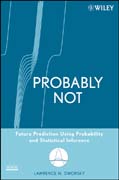
Probably not: future prediction using probability and statistical inference
Dworsky, Lawrence N.
Probably Not is intended to be both entertaining and educational in an area that is central to everyday life. The examples provided in the book exemplify how we are living in a statistical world, what we can expect, what we really know based upon the information at hand, and also explains when we only think weknow something. The book begins with an introduction needed to further explore the connection between predication and probability, and the subsequent chapters include coverage of: insurance, gambling, and the Precautionary Principle;coin flip games; Central Limit Theorem; binomial distributions and Poisson distributions; medical tests; and more. INDICE: Introduction. 1. An Introduction to Probability. Predicting The Future. Rule Making. Random Events and Probability. The Lottery {Very ImprobableEvents and Large Data Sets}. Coin Flipping {Fair Games, Looking Backwards ForInsight}. The Coin Flip Strategy That Cant Lose. The Prize Behind The Door {Looking Backwards For Insight, Again}. The Checker Board {Dealing With Only Part Of The Data Set}. 2. Probability Distribution Functions And Some Basics. TheProbability Distribution Function. Averages And Weighted Averages. Expected Values. The Basic Coin Flip Game. The Standard Deviation. The Cumulative Distribution Function. The Confidence Interval. Final Points. 3. Building a Bell. 4.Random Walks. The One Dimensional Random Walk. What Probability Really Means.Diffusion. 5. Life Insurance and Social Security. Insurance as Gambling. LifeTables. Birth Rates and Population Stability. Life Tables, Again. Premiums. Social Security - Sooner Or Later?. 6. Binomial Probabilities. The Binomial Probability Formula. Permutations And Combinations. Large Number Approximations. The Poisson Distribution. Disease Clusters. Clusters. 7. Pseudorandom Numbers and Monte Carlo Simulations. Pseudorandom Numbers. The Middle Square PSNG. TheLinear Congruential PSNG. A Normal Distribution Generator. An Arbitrary Distribution Generator. Monte Carlo Simulations. A League Of Our Own. 8. Some Gambling Games In Detail. The Basic Coin Flip Game. The Gantt Chart. The Ultimate ‘Winning Strategy’. The Game Show. Parimutuel Betting. 9. Traffic Lights And Traffic. Outsmarting A Traffic Light?. Many Lights And Many Cars. Simulating Traffic Flow - The Simulation. Simulation Results. 10. Combined And Conditional Probabilities. Functional Notation. Conditional Probability. Medical Test Results. The Shared Birthday Problem. 11. Scheduling And Waiting. Scheduling Appointments In The Doctors Office. Lunch With A Friend. Waiting For A Bus. 12. Stock Market Portfolios. 13. Benford, Parrondo and Simpson. Benfords Law. Parrondos Paradox. Simpsons Paradox. 14. Networks, Infectious Disease Propagation and Chain Letters. Degrees Of Separation. Propagation Along Networks. Some Other Uses Of Networks. Neighborhood Chains. 15. Bird Counting. A Walk In The Woods. A Model Of Bird Flying Habits. Spotting A Bird. Putting It All Together. 16. Statistical Mechanics And Heat. Statistical Mechanics. Thermodynamics. 17. Introduction To Statistical Analysis. Sampling. Sample Distributions and Standard Deviations. Estimating Population Average From A Sample. The Student-T Distribution. Polling Statistics. Did A Sample Come From A Given Population?. 18. Chaos and Quanta. Chaos. Probability In Quantum Mechanics.
- ISBN: 978-0-470-18401-1
- Editorial: John Wiley & Sons
- Encuadernacion: Rústica
- Páginas: 310
- Fecha Publicación: 02/05/2008
- Nº Volúmenes: 1
- Idioma: Inglés
